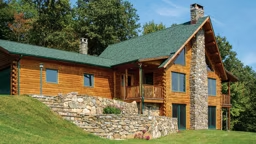
Photo: mary_photo / fotolia
Russians have a unique and special attitude with respect to their forest resources. This attitude is based on old Orthodox culture and Russian rituals associated with logging and construction. Russians have used wood to build everything from simple peasant homes to elaborate breathtaking cultural statements such as Tsar Alexei Wooden Palace, famed for its fairytale style roofs.
A History of Russian Log Home Architecture
A simple, concise form of housing, wood-construction techniques showing outstanding skills of Russian architects was honed over centuries and used extensively for housing. The result is a raft of handcrafted buildings that have been handed down for generations. In St. Petersburg alone, there are more than 18,000 peasant wooden houses and buildings that were built before 1917 and are still in good condition. And since the construction of housing in Russia’s vast territory covers a variety of
climatic zones, which largely determine the type of structure needed, the architecture of the houses varies considerably by region.
However, only a fraction of the historical large monuments and associated documentaries on Russia’s wooden buildings relating to the end of the 19th century have survived. Unlike the peasant dwelling or wooden church architecture, large mansions and palaces, unfortunately, did not survive the numerous wars and fires. Except for the occasional few manor buildings, which themselves are in poor condition, information about earlier period monuments must be drawn from archaeological materials, paintings by famous artists, historical manuscripts and the vast number of peasant cabins that have survived. The skill of the ancient Russian handcrafters impresses our contemporary architects.
Wooden houses were built from logs without using a single nail while using a wide variety of carpentry techniques. The peasant buildings or ensembles of royal mansions combined the monumentality of blockhouses and light-frame extensions and summer rooms with sacramental and scenic interior and exterior trim.
The Axe vs. the Saw
 Photo: Srdjan / fotolia
Photo: Srdjan / fotolia
In areas rich in forests containing pine, oak, hickory and other hard woods, it was mainly the pine tree that was used in the construction of log houses and rarely the deciduous trees. The long straight trunk of the pine tree combined with the skill of the ax man permitted a nearly airtight stacking of the logs. Among the large variety of methods for stacking the logs were “in a paw,” “in a cup” and “swallow tail” techniques, which have been used successfully to date.
The axe, which of course was used for felling the trees, was also the carpenter’s main tool. It should be noted that Russian ancestors were axe virtuosos. With this universal tool, they did almost all the work, from logging to carved elements on the facade. The secret to the popularity of
the axe is simple. The fact is that in the old days, it was observed that sawed wood is more susceptible to moisture and decay when compared to wood processed with an axe. The compressing blows of the axe make the wood less hygroscopic. Therefore, despite the fact that the saw was known for a long time, they rarely used it.
A Variety of Russian Log Cabin Designs

Photo: dimbar76 / fotolia
Russia is known for more than 50 types of log cabin designs. However, the most common was the simple five-wall cabin, which is a four-wall rectangular house divided with a fifth wall to create two halves, usually equal. This design created a large living area with windows for good lighting and a stove or earthen hearth for heating and cooking and a smaller sized ‘business’ area, which was typically used for shelter of livestock or grain. If the family did not have need of a ‘business’ side, they would often have a doorway connecting the halves. Openings in the walls were small to avoid having to cut logs and to minimize heat loss. However, windows were common and came in a variety of styles that were typically ornate on the exterior reflecting the craftsmanship of the builder.
Creativity in the utility of windows was also exhibited such as in the “sliding” window, where the hole was cut down in the middle of two logs and a track carved into the wood for sliding a board across the opening. Over time, these windows were replaced with mica, and only in 18th and 19th centuries did builders begin to use glass.
Rough boards from splitting logs were used for doorways, and floors were typically made of clay. To complete the interior furnishings of these log homes, large stones were placed in the corners as seating areas, or thick logs were installed at various levels of the log wall to act as chairs or shelving.
Larch or oak woods with great resistance to decay were used for these chairs. To increase this resistance, wood was often burned at the stake or coated with tar. Foundations for wooden buildings were not set in concrete or other such materials but were made by placing logs directly on the ground.
This, of course, often resulted in moisture gaining access to the interior and thus, over time, more and more buildings were constructed with a mezzanine and a loft on the upper floor. In regions with long snowy winters, wooden floors were raised as high as possible above the ground to protect the house from moisture and create an additional space in which to store supplies, grain and livestock under these floors.
Russian Log Home Roofing Techniques
 Photo: EhayDy / fotolia
Photo: EhayDy / fotolia
One of the oldest methods of construction of the roof is the
gable design, the essence of which was the fact that the logs gables shorten the closer to the ridge they are creating a triangle roof.
Such simple construction techniques for the roof were used until the end of 19th century, when the use of truss structure became dominant and which is preserved to this day almost unchanged. During the construction of churches and castles the ridges were improved, taking the form of bulbs, the crown of which was a cross, pole or other wooden decorations.
For centuries Russian log home architecture relied heavily on shingles for
roofing. Shingles were made of wood from fir, ash and, most often, spruce. Properly made shingles were called cracked shingles. They used straight pieces of tree trunk, located between the separate branches with a minimum number of knots and a length of 24 inches. Shingles were axed radially around the tree trunk.
To do this, an ax and a hammer were used to make wedge-shaped pieces of wood with a thickness of 3/4 inch. Each piece was treated with a two-handed wedge cutter that got the tear-shaped parts to a thickness that tapered to about 3/8 inch. A special tool — the shingled strug — was used to cut grooves lengthwise, and then the shingles were dried for six months. When ready for use, the shingles were impregnated with anthracene oil and painted.
Modern Techniques in Russian Log Cabin Design

Photo: Антон Фрунзе / fotolia
In Russia, handcrafted log houses competed successfully with stone houses for centuries. But in the first half of last century, devastation caused by civil war forced builders to find a cheaper alternative. The production of panel prefabricated wooden houses using examples of houses in Sweden and Finland first started in St. Petersburg. The low cost and short time of construction of these houses have attracted a lot of fans, and the houses were called “Finnish.”
Popular collapsible designs came after World War II to provide the population with cheap and fast-built housing. The best architects were involved to create cheap complex projects for rural construction. Many of those houses built are preserved to this day, giving shelter to several generations of Russians.
The 21st century has set completely new challenges for log-home manufacturers. The use of high-performance construction materials has transformed the art of wooden home construction into a higher level of Russia’ s traditional architectural and building systems from solid wood (with milled and round logs) to frame and panel. Logs, themselves strong and solid, are now enhanced and protected with high-tech sealants, and coatings vastly extend the life of the log buildings.
As an example, 10 years ago Perma-Chink Systems introduced flexible chinking to the Russian log-home market, replacing the old Russian technique of “konopatki,” or sealing gaps between the logs with hemp, dry moss, etc.
See also: Sagamore: The National Historic Landmark in the Adirondacks
















